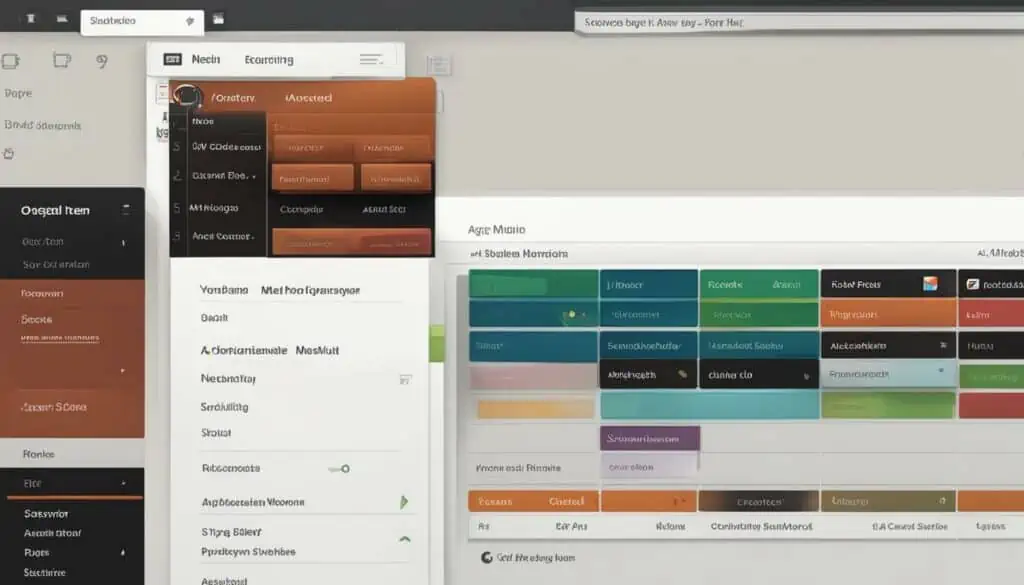When it comes to creating an exceptional browsing experience for your website visitors, user-friendly navigation is key. With easy website navigation, you can guide users effortlessly through your site, increasing their engagement and satisfaction. A well-designed and intuitive navigation menu ensures that users can find what they need quickly and efficiently, leading to lower bounce rates, increased time on site, and improved conversion rates.
In a recent survey, it was found that only 50% of internet users were able to predict where relevant content would be based on standard website navigation structure. This statistic highlights the importance of implementing a navigation system that is user-friendly and easy to navigate.
To achieve efficient site navigation, consider the following best practices:
Table of Contents
Key Takeaways:
- Create an intuitive and easy-to-understand navigation menu to guide users through your site.
- Implement responsive navigation that adapts to different devices and screen sizes.
- Ensure accessibility by using proper HTML tags and attributes for assistive technologies.
- Follow conventional placement of navigation menus for familiarity and ease of use.
- Simplify and prioritize your menu choices to maximize user decision-making.
By following these practices, you can enhance your site’s navigation and provide an optimal user experience for your visitors. With user-friendly navigation, you can keep users engaged, improve conversions, and ultimately drive the success of your online presence.
What is Website Navigation?
Website navigation is a fundamental aspect of browsing the internet. It involves the process of navigating through pages, apps, and websites with ease. This navigation is enabled by the use of hypertext or hypermedia technology, which connects text-based web pages through hyperlinks. These hyperlinks can be both internal, leading to different pages within the same domain, or external, directing users to pages on other domains.
A well-designed website navigation system is essential for creating a user-friendly site. It employs menus with internal links, allowing visitors to navigate and find their desired content efficiently. By guiding users to relevant information, website navigation enhances the overall user experience.
Internal links within website navigation menus play a crucial role in ensuring that users can easily find the content they are looking for. These links allow visitors to access different pages within the same website domain, improving site exploration and discovery. External links, on the other hand, provide opportunities for users to explore resources, information, or services outside of the current website domain.
Benefits of User-Friendly Website Navigation
- Aids in discovering relevant content
- Enhances user experience and engagement
- Improves site navigation efficiency
- Reduces bounce rates
- Influences conversion rates positively
Implementing a user-friendly navigation system on your website is essential for creating a positive browsing experience for your visitors. By incorporating intuitive website navigation design and strategically placing internal and external links, you can guide users effectively and keep them engaged with your site’s content.
Creating a user-friendly site with efficient navigation is vital to ensure that visitors can easily find the information they are looking for. By optimizing your site’s navigation system, you can improve user satisfaction, increase traffic, and boost conversions. In the next section, we will explore different types of website navigation that can be implemented to enhance the user experience and streamline content accessibility.
Types of Website Navigation
In order to create a seamless browsing experience and guide users through your website, it is important to understand the different types of navigation available. There are three main types: global navigation, hierarchical navigation, and local navigation.
Global Website Navigation
Global navigation involves a menu with identical links that appear consistently across all pages of your website. This type of navigation provides users with access to important pages regardless of their location on the site. It ensures that key pages, such as the homepage or contact page, are easily accessible from any page.
Hierarchical Website Navigation
Hierarchical navigation is based on menus that change dynamically depending on the context. It includes submenus that reveal additional links related to a specific category or section. This type of navigation allows users to navigate through the website in a structured manner, drilling down into specific areas of interest. It is particularly useful for websites with a large amount of content organized into different categories.
Local Website Navigation
Local navigation refers to internal links embedded within the content itself. These links provide users with additional navigation options that are specific to the current page or topic. Local navigation allows users to explore related pages or access additional resources without having to rely solely on the main navigation menu. It enhances the user experience by offering more targeted and contextually relevant navigation choices.
Each type of navigation serves a specific purpose and should be implemented based on the content structure and user needs of your website. A combination of global, hierarchical, and local navigation can provide a comprehensive and user-friendly navigation system that guides visitors through your website effortlessly.
Best Practices for User-Friendly Navigation
Creating a user-friendly navigation menu is essential for enhancing the overall user experience on your website. By following best practices and conventions, you can ensure that your menu is responsive, accessible, and optimized for different devices and user needs.
Responsive Navigation
A responsive navigation menu is crucial in today’s mobile-centric world. It allows your menu to adapt seamlessly to various screen sizes and devices, providing an optimal browsing experience. Implementing responsive design techniques and frameworks like Bootstrap can help you achieve a menu that works well on desktops, tablets, and smartphones.
Accessibility
Accessibility is another critical aspect of user-friendly navigation. It ensures that individuals with disabilities can navigate through your menu using screen readers and other assistive technologies. To make your menu accessible, use proper HTML tags and attributes, such as the alt attribute for images. This enables screen readers to provide accurate descriptions of menu items.
Conventional Placement and Style
Following conventional placement and style for your navigation menu is a best practice that helps users find their way around your site more easily. Typically, menus are placed at the top or left side of the page, where users expect to find them. Consistency in style and color scheme throughout your menu also enhances the user experience.
Avoid Complex Dropdown Menus
Complex dropdown menus can be overwhelming and confusing for users. Instead, consider using breadcrumbs or secondary menus to provide additional navigation options. Breadcrumbs show users their current location within your site and allow them to backtrack easily. Secondary menus offer more options related to specific categories or sections.
Implementing these best practices for user-friendly navigation will help your website deliver an intuitive and efficient browsing experience. By making your menu responsive and accessible, following conventional placement and style, and avoiding complex dropdowns, you can create a navigation menu that keeps users engaged and guides them to the content they seek.
Simplify and Prioritize Navigation Choices
When it comes to optimizing your navigation menu, simplicity is key. By keeping your menu choices to a minimum, you not only improve the search engine optimization of your website but also enhance the user experience. According to Miller’s Law, limiting the number of choices speeds up decision-making and helps users remember the menu structure more easily. Therefore, it’s important to prioritize the most important choices and eliminate unnecessary clutter from your menu.
In addition to minimal menu choices, understanding the concept of information architecture is essential. Information architecture refers to the organization and structure of information within your website. By creating a clear and logical hierarchy, you can guide users to their desired content more effectively. This involves categorizing information, creating intuitive labels, and establishing a seamless flow between pages.
Another technique to consider is the serial position effect. This psychological phenomenon suggests that users have better recall for the first and last items in a list. Applying this principle to your navigation menu, you should place important links at the beginning and end to increase their visibility and impact. By doing so, you can enhance user navigation, ensuring that they find the most relevant content on your website.
To illustrate the importance of simplifying and prioritizing navigation choices, the following table highlights the differences between a menu with minimal choices and one with excessive options:
| Minimal Menu Choices | Excessive Menu Choices |
|---|---|
|
|
The table clearly demonstrates the advantages of a minimal menu. With fewer choices, users can easily navigate through the website and quickly find what they’re looking for. In contrast, an excessive menu overwhelms users and makes it difficult to locate specific content.
By simplifying your navigation choices and optimizing your information architecture, you can create a user-friendly website that facilitates seamless navigation and enhances the overall user experience.
Test and Optimize Your Menu
Regularly testing and optimizing your navigation menu is crucial to ensure it effectively meets the needs of your users. By gathering data through tools like Google Analytics, heatmaps, and user testing, you can gain insights into how users interact with your menu and identify any areas for improvement or potential issues.
A/B testing and multivariate testing are effective strategies to compare different versions of your menu and analyze user behavior and conversion rates. By experimenting with various menu layouts, designs, and content, you can make data-driven decisions to optimize your menu’s performance.
Keeping your menu updated and relevant to your content and goals is essential for providing the best user experience and maximizing engagement. Analyze user behavior and conversion rates to identify patterns and make informed adjustments to your menu structure and content.
Remember to incorporate relevant keywords, intuitive navigation design, and user-friendly features into your menu optimization process. By prioritizing user needs and continuously improving your menu based on data-driven insights, you can enhance user satisfaction, increase conversions, and ultimately drive the success of your website.
Example of Menu Optimization Testing
| Testing Variant | User Behavior | Conversion Rate |
|---|---|---|
| Original Menu | High click rate on irrelevant links Longer navigation time High bounce rate |
4.5% |
| Revised Menu 1 | Lower click rate on irrelevant links Shorter navigation time Improved engagement |
6.2% |
| Revised Menu 2 | Significant decrease in bounce rate Higher click rate on relevant links Increased user satisfaction |
7.8% |
The table above demonstrates the impact of menu optimization testing on user behavior and conversion rates. By comparing the performance of different menu variants, it is evident that the revised menu options resulted in improved user engagement and higher conversion rates.
Through careful analysis of user behavior and conversion rates, you can make informed decisions to optimize your navigation menu and deliver an exceptional user experience.
The Importance of Responsive and Accessible Navigation
Making your navigation menu responsive and accessible is crucial for providing a seamless user experience, especially on mobile devices. Nowadays, more and more people are accessing websites through their smartphones or tablets, and having a mobile-friendly navigation menu is essential to ensure that users can easily navigate your site regardless of the device they are using.
Responsive design is a key aspect of mobile navigation. It allows your website to adapt to different screen sizes, ensuring that your navigation menu remains user-friendly and visually appealing on any device. By using responsive design techniques and frameworks like Bootstrap, you can create a navigation menu that is optimized for various devices, providing an optimal user experience.
Accessibility is another important consideration when it comes to navigation. It is essential to make your menu accessible to all users, including those with disabilities. By using proper HTML tags, attributes, and ARIA roles, you can ensure that assistive technologies can navigate through your menu effectively. Considering the needs of users with disabilities is not only an ethical responsibility but also improves the overall user experience for all users.
By prioritizing responsive design and accessibility in your navigation menu, you can enhance the user experience and ensure that users can effortlessly navigate through your website on any device. This will not only improve user satisfaction but also boost engagement and ultimately drive the success of your online presence.
| Factors | Responsive Design | Accessibility |
|---|---|---|
| Definition | Adapts to different screen sizes | Ensures usability for users with disabilities |
| Importance | Easier navigation on mobile devices | Inclusive user experience |
| Implementation | Responsive design techniques and frameworks | Proper HTML tags, attributes, and ARIA roles |
| Benefits | Improved user experience on different devices | Easier navigation for users with disabilities |
Improve User Experience with Visual Hierarchy
To enhance the user experience of your navigation menu, it is essential to utilize the concept of visual hierarchy. By creating a logical and visual relationship between design elements, you can guide users through your menu with ease. Visual hierarchy involves grouping related items and using size, color, or font weight to highlight important links, thereby drawing users’ attention.
One effective way to implement visual hierarchy is by using different font sizes or colors for different categories. This allows users to quickly identify the importance of each element and prioritize their navigation choices accordingly. By organizing and designing your menu with visual hierarchy in mind, you can create a more intuitive and engaging browsing experience.
Visual cues also play a crucial role in providing directional guidance within your navigation menu. By utilizing visual cues, such as arrows or icons, you can guide users to important menu items and help them understand the structure of your site. These cues act as signposts, improving the clarity and usability of your navigation menu.
Visual hierarchy and cues contribute to the overall user experience by making it easier for users to navigate your site and find the information they need. By utilizing design principles like visual hierarchy and directional cues, you can optimize your navigation menu and create a seamless browsing experience.
Design Principles for Visual Hierarchy
When implementing visual hierarchy in your navigation menu, consider the following design principles:
- Grouping: Group related menu items together to create a sense of organization and coherence.
- Size: Use larger font sizes or visual elements to emphasize important links or categories.
- Color: Utilize contrasting colors or shades to differentiate between different levels of importance.
- Font Weight: Use bold or italicized text to highlight crucial information or actions.
By applying these design principles, you can effectively establish a visual hierarchy within your navigation menu and improve the overall user experience.
Benefits of Visual Hierarchy in Navigation
The implementation of visual hierarchy offers several benefits for your navigation menu:
- Improved User Engagement: A well-structured navigation menu improves user engagement by guiding them to relevant content efficiently.
- Enhanced User Satisfaction: Visual hierarchy ensures that users can easily find what they’re looking for, resulting in higher satisfaction levels.
- Reduced User Confusion: Clear visual cues and organized design elements reduce user confusion and provide a more intuitive browsing experience.
- Increased Conversion Rates: By making it easier for users to navigate through your site, visual hierarchy can positively impact conversion rates.
By leveraging visual hierarchy and implementing design principles, you can significantly enhance the user experience of your navigation menu and improve the overall success of your website.
Conclusion
User-friendly navigation is a vital component in optimizing your website and ensuring an optimal user experience. By implementing the best practices outlined in this article, you can create a navigation menu that is intuitive, efficient, and tailored to meet the needs of your users across different devices. Regular testing and optimization are key to ensuring that your navigation menu continues to meet user preferences and expectations.
By prioritizing simplicity, accessibility, and visual hierarchy, you can guide users through your site with ease, resulting in lower bounce rates, increased time spent on site, and improved conversion rates. It is essential to invest in the optimization of your website’s navigation to provide users with the best possible experience and drive the success of your online presence.
Remember, a well-designed and user-friendly navigation menu not only allows visitors to find what they are looking for more easily but also helps create a positive impression of your website and brand. By integrating these principles into your website, you can ensure that users can effortlessly navigate through your content, enhancing engagement and facilitating their desired actions.
FAQ
What is user-friendly navigation?
User-friendly navigation refers to the design and structure of a website’s menu system that makes it easy for users to navigate and find the desired content.
Why is website navigation important?
Website navigation is important because it helps users to navigate through different pages, apps, and websites, making it easier for them to find relevant content and have a seamless browsing experience.
What are the types of website navigation?
The three main types of website navigation are global navigation, hierarchical navigation, and local navigation. Each serves a different purpose in guiding users through a website’s content.
What are some best practices for user-friendly navigation?
To ensure user-friendly navigation, it is important to make the menu responsive, accessible, and follow design conventions. Placing the menu at the top or left of the page and using a consistent style and color scheme are also recommended.
How can I simplify and prioritize navigation choices?
To simplify and prioritize navigation choices, it is best to keep the menu items to a minimum. By following Miller’s Law and the serial position effect, you can speed up decision-making and help users remember the menu structure.
How can I test and optimize my menu?
You can test and optimize your menu by using tools like Google Analytics, heatmaps, and user testing. A/B testing or multivariate testing can also be used to compare different versions of the menu and analyze user behavior and conversion rates.
Why is responsive and accessible navigation important?
Responsive and accessible navigation is important because it ensures that users can navigate through your website seamlessly, regardless of the device they are using or any disabilities they may have. It improves the overall user experience and engagement.
How can visual hierarchy improve user experience?
Visual hierarchy can improve user experience by creating a logical and visual relationship between design elements in the navigation menu. By using size, color, or font weight to highlight important links, visual cues can guide users to important menu items and provide directional guidance.





